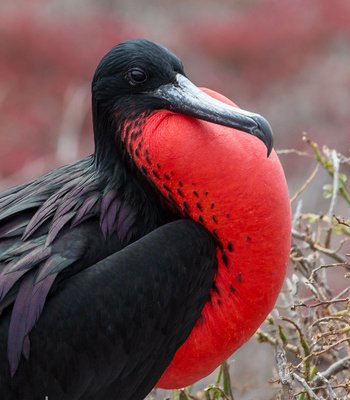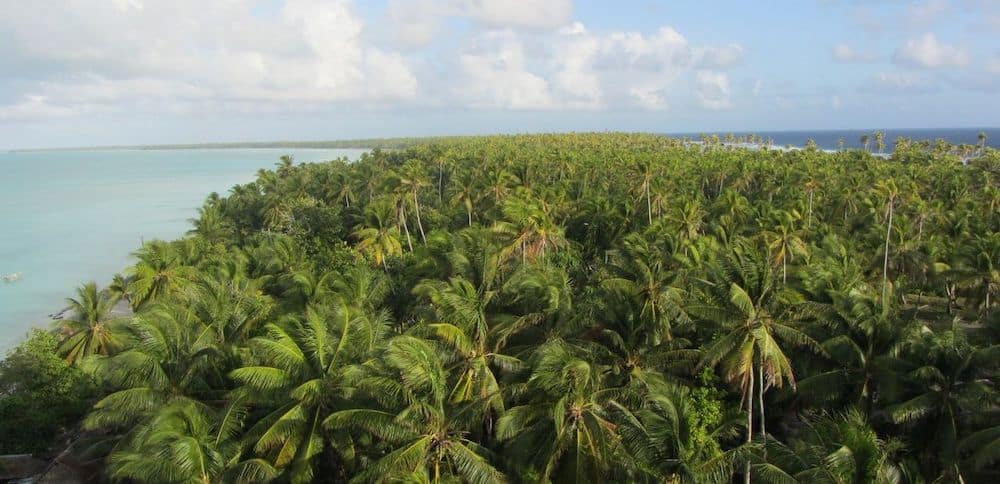Republic of Kiribati

Kiribati is an island country in the Micronesia sub-region of Oceania in the central Pacific Ocean. Its population is c.135,000 people with more than half living on Tarawa atoll. The state comprises 32 atolls and one remote raised coral island, Banaba. Its total land area is a little over 800 km2 (300 square miles) dispersed over 3,442,000 km2 (1,329,000 square miles) of ocean. It is sub-divided into three main groups known as the Gilbert Islands (16 atolls), the Phoenix Islands (8 atolls) & the Line Islands (8 atolls and 1 reef) and separately Banaba (1 island). The islands’ spread straddles the equator and the 180th meridian, making Kiribati the only country in the world located simultaneously in all four hemispheres: the Northern, Southern, Western, and Eastern. The International Date Line goes around Kiribati and swings far to the east, almost reaching 150°W. This brings Kiribati’s easternmost islands, the southern Line Islands south of Hawaii, into the same day as the Gilbert Islands and places them in the most advanced time zone on Earth: UTC+14.
Kiribati has very few natural resources. Originally, the islands had phosphate deposits, but those were exhausted by the time the country gained it independence from Britain (1979).
The bulk of natural resources and national exports now are copra and fish. 2.7% or about 2,000 hectares of Kiribati is forested. Temperature varies between 25 °C and 33 °C and 50 to 63 per cent of annual possible sunshine of 4135 hours. The wet season extends from December to May and rainfall variation is high in most of the islands. A gentle breeze from the easterly quarter is predominant.

Abaiang Island – ©Flexman, CC BY-SA 3.0 via Wikimedia Commons
The United Nations Intergovernmental Panel on Climate Change predicts that sea levels will rise by about half a metre (20 in) by 2100 due to global warming and a further rise would be inevitable. It is thus likely that within a century the nation’s arable land will become subject to increased soil salinisation and will be largely submerged. Global warming is by far the single largest threat faced by Kiribati. The biggest threat from global warming is flooding of the islands, rendering them uninhabitable. However, freshwater salinisation and erosion are also dangers. Exotic species are dangers on the biodiversity front. Most of the islands have been affected by this threat. For example, large feral cats have driven most of the species of birds to nesting only on isolated islets. Man’s poaching, enhanced by access to new vehicles which can reach bird colonies, has threatened other species of birds. Also, exotic plants have been introduced, causing harmful effects among some sea bird species. A final issue is the pollution of lagoons due to increased population and the ensuing dumping of waste products, leading to groundwater sources being at risk.
Birding Kiribati
Because the Islands are so isolated geographically some are a sanctuary and breeding ground for Pacific seabirds. Kiritimati island alone supports 18 different species of birds, including the endemic Christmas Island Reed Warbler. The island is also home, and a population stronghold, to the endangered Phoenix Petrel and the White Throated Storm Petrel. Kiritimati (Christmas Island) was used to test nuclear bombs in the 1950s.

Kiritimati – ©Calvin Smith CC BY 2.0 via Wikimedia Commons
The entire island is designated as a Wildlife Sanctuary and access to five particularly sensitive areas is restricted. The natural vegetation on Kiritimati consists mostly of low shrubs and grassland. What little woodland exists is mainly open coconut palm plantation. There are three small woods of catchbird trees at Southeast Point, Northwest Point, and on Motu Tabu.
There are nine designated protected zones to support the breeding and nesting of the various bird species on Kiritimati, which takes it role in supporting these birds very seriously. The Kiribati Ministry for Wildlife and Conservation is responsible for ensuring the breeding grounds are not disturbed. While seabirds can nest and breed throughout the year, as there is little temperature fluctuation, the most common breeding months are June and December.

Christmas Island Shearwaters – ©Duncan Wright, USFWS, Public domain, via Wikimedia Commons
More than 35 bird species have been recorded from Kiritimati. Nesting birds include: Phoenix Shearwaters, Wedge-tailed Shearwaters, Christmas Island Shearwaters, Audubon’s Shearwaters, Polynesian Storm Petrels, Red-tailed Tropicbirds, Masked Boobies, Brown Boobies, Great Frigate Birds, Red-footed Boobies, Lesser Frigate Birds, Great Crested Terns, Grey-backed Terns, Sooty Terns, Brown Noddies, Black Noddies, Blue-grey Noddies and White Terns.
In Central Kiribati the Phoenix Island Protected Area also supports an extensive bird colony and nesting habitat.
Across the group there are a few passerine species as well as visiting seabirds, waders, herons & cormorants etc.
-
Number of bird species: 90
(As at July 2024)
Number of endemics: 1
Kiritimati Reed-warbler Acrocephalus aequinoctialis
-
Avibase
PDF ChecklistThis checklist includes all bird species found in Kiribati , based on the best information available at this time. It is based on a wide variety of sources that I collated over many years. I am pleased to offer these checklists as a service to birdwatchers. If you find any error, please do not hesitate to report them. -
Wikipedia
Annotated ListThis is a list of the bird species recorded in Kiribati, an island nation in the central Pacific Ocean. The avifauna of Kiribati include a total of 90 species, of which two are endemic, and 3 have been introduced by humans. -
eBird
PDF ChecklistThis checklist is generated with data from eBird (ebird.org), a global database of bird sightings from birders like you. If you enjoy this checklist, please consider contributing your sightings to eBird. It is 100% free to take part, and your observations will help support birders, researchers, and conservationists worldwide.
-
Birds of Eastern Polynesia: A Biogeographic Atlas
| By Jean-Claude Thibault & Alice Cibois | Lynx Edicions | 2017 | Hardback | 438 pages, 200 colour photos and illustrations, 70 b/w illustrations, 142 colour distribution maps | ISBN: 9788416728053 Buy this book from NHBS.com -
Birds of Melanesia
| By Guy Dutson | Helm | 2011 | Paperback | 447 pages, 75 colour plates, colour photos, colour maps, b/w illustrations, tables | ISBN: 9780713665406 Buy this book from NHBS.com -
Checklist of the Birds of Micronesia
| By P Pyle & J Engbring | Hawaii Audubon Society | 1985 | Unbound | 12 pages, no illustrations | ISBN: #16988 Buy this book from NHBS.com
-
Wildlife Conservation Unit
WebsiteThe Wildlife Conservation Unit (WCU) is responsible for safeguarding all native wildlife on Kiritimati Island, as well as other islands in the Line and Pheonix Groups.
-
Protected areas of Kiribati
InformationSatellite ViewProtected areas of Kiribati include marine protected areas managed by the Environment and Conservation Division, of the Kiribati Ministry of Environment, Lands and Agricultural Development. Kiribati, in partnership with the New England Aquarium and Conservation International (CI), manages the Phoenix Islands Protected Area (PIPA), which is a World Heritage Site that was established in 2006, and is the second largest of the world's marine protected areas. The U.S. administered Pacific Remote Islands Marine National Monument is currently the world's largest designated marine protected area (MPA), and is to the north and north-east of the PIPA. There is one wetland of international importance that is registered under the Ramsar Convention. A total of 22 Key Biodiversity Areas (KBAs) - areas of high biodiversity and conservation value - have been identified in Kiribati.
-
Kiribati Holidays
Tour OperatorWith 9 protected nesting zones, covering a large proportion of the island, Kiritimati is a haven for birdlife. Large colonies of rare migratory seabirds, many of which are ground nesting, remain unafraid of human activity, enabling close observation. Kiritimati is a birdwatcher’s paradise.
-
Bird Watching in Kiribati
WebpageKiritimati Island is a sanctuary and breeding ground in the Pacific for seabirds. With very little land in any direction, Kiritimati supports 18 different species of birds, including the endemic Christmas Island Warbler. The island is also home, and a population stronghold, to the endangered Phoenix Petrel and the White Throated Storm Petrel. -
Flora and Fauna of Kiribati
WebsiteThe Flora and Fauna of Kiribati aptly complement the humid and wet climate of the Kiribati islands

